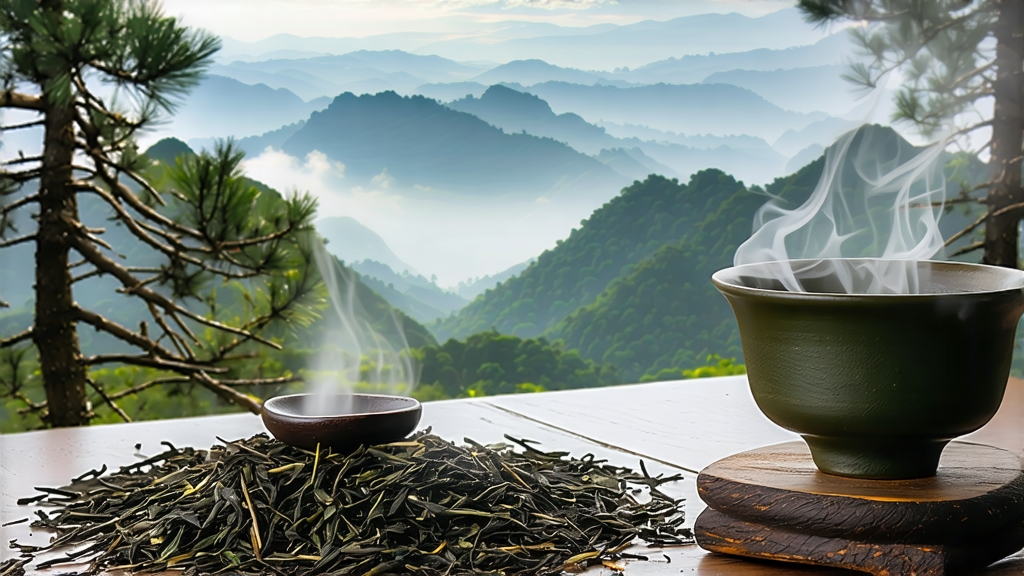
Long before English breakfast blends and Assam gardens existed, the global story of black tea began in the rugged Wuyi Mountains of northern Fujian with a leaf called Lapsang Souchong. To many Westerners the name evokes a pungent campfire aroma, yet within China the same tea is celebrated for its deep cocoa sweetness and long, wine-like finish. Understanding both faces—smoky export icon and refined local treasure—offers a window into how one cultivar shaped trade routes, royal courts and modern palates alike.
Historical records from the Ming Dynasty (1368-1644) first mention “Xiao Zhong” (small-leaf variety) being fully oxidised to survive the humid voyage down the Min River to the port of Xiamen. By 1604 Dutch merchants had shipped it to Europe where it was christened “Lapsang”—a romanisation of the local place-name Lapu Mountain—and “Souchong,” referring to the fourth or fifth leaf picked, larger and tougher than the prized budsets used for green tea. The British East India Company made it the template for every “black” tea that followed, so much so that in Victorian London “Bohea” (the older name for Wuyi teas) became a synonym for tea itself.
The tea belongs to the Camellia sinensis var. sinensis ecotype, but centuries of seed propagation have created a genetic mosaic of bushes that hug granite cliffs between 600 m and 1 200 m elevation. Cool nights, frequent fog and mineral-rich runoff slow growth, concentrating polyphenols and aromatics. Two clonal sub-cultivars dominate today: Cai Cha (colourful leaf) prized for fruity notes, and Ye Cha (wild leaf) that carries higher lignin, ideal for absorbing pine smoke without tasting acrid.
Craft begins when the sun rises over the bamboo-lined paths of Tongmu Village, the only legally protected core origin. Pickers pluck one bud with three or four mature leaves, a standard that looks coarse compared with green-tea finesse yet is essential for the coming withering marathon. Baskets are carried to a three-storey wooden house whose top floor is latticed with bamboo mats; here, the leaves lose 60 % moisture over eight hours in the gentle heat rising from ground-floor smoking pits. Every 30 minutes the tea master shakes the mats, ensuring even wilting and initiating enzymatic oxidation that turns the leaf edge a reddish copper.
Once limp, leaves are rolled under low pressure for 45 minutes; cell walls fracture, releasing juices that will later caramelise. They are then placed into deep bamboo drums lined with wet cotton cloths to ferment for three to four hours at 26 °C. During this critical phase catechins convert to theaflavins and thearubigins, gifting the brick-red liquor and brisk mouthfeel that define black tea. When the aroma shifts from grassy to ripe peach, the master knows oxidation is complete.
What follows is the step that split Lapsang into two commercial identities. For the traditional “smoked” style, the same pine wood (Pinus massoniana) that heats the house is now dampened and set to smoulder. A screen of fine mesh prevents leaves from touching flames while allowing resinous smoke to permeate for six to eight hours. The process is repeated up to three cycles, each cooler and longer, layering phenols such as guaiacol and syringol that create the signature whisky-like nose. In contrast, the “unsmoked” or Zheng Shan Xiao Zhong style, promoted since 2005 for the domestic market, skips the final smoking. Instead, leaves are baked over glowing charcoal made from local hardwood, yielding a malt-cocoa profile closer to Assam yet still laced with Wuyi minerality.
Drying finishes the journey. Both versions are pan-fired at 80 °C to lock in 4–5 % residual moisture, then rested for at least 30 days so disparate aromas marry. A final hand-sort removes yellow flakes and stem, leaving only sleek, jet-black strips that curl like eagle talons.
To brew, treat Lapsang as you would a peated single-malt: respect the smoke but chase the sweetness beneath. Gongfu style best reveals its evolving acts. Pre-heat a 120 ml gaiwan or tiny Yixing pot made from duan ni clay whose porosity softens tarry edges. Use 5 g of